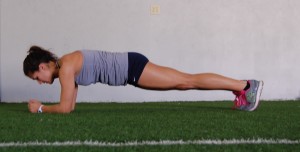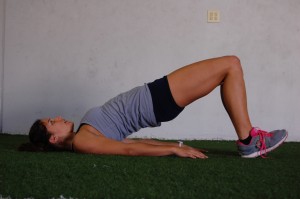By: Eric McGinnis, CSCSSports Performance Specialist, Rollins College Strength CoachSpectrum Sports Performance
If you’re like most people, you hate to warm up and you don’t do it well enough. I’m not judging you. In fact I totally understand. A warm up is the last thing I want to do when I’m mentally psyched up to go crush some iron in the weight room. But no matter how many times you tell yourself that a lion doesn’t warm-up before it attacks its prey, that’s not going to save your hamstrings from tearing off like a pair of break-away pants when you make your cold muscles take off into a full sprint.
Lack of motivation is only one reason we don’t warm-up. Everyone knows it’s important for both improved performance and injury prevention, so why don’t we do a better job of it? Lack of knowledge on how to implement a proper warm-up is the underlying factor. In this entry I’m going to break down how you can structure a simple, easy, and effective warm-up for an event or training session so that you won’t skip out on this important piece of performance.
STEP 1: SELF-MASSAGE
Self-massage (or self myofacial release) is an important step in the warm-up for a lot of reasons. Constant reoccurring stresses and static positions from our lives cause adhesions in our muscles and their surrounding soft tissue. This can create issues in range of motion and elasticity. It’s a good idea to use various massage tools such as a foam roller, tennis ball, lacrosse ball, or massage stick to help restore the muscles to their normal length. In order to get these knots to release you’re going to have to spend some time easily working into those tender spots in the muscle. Spend about 2-3 minutes prioritizing the areas that cause the most problems for you. Remember to keep the muscles relaxed while massaging.
STEP 2: DYNAMIC PREPARATION
The primary goals of this phase are to increase core temperature, lubricate the joints, and improve range of motion in the muscles. This phase can be broken down into 2 sub-segments: A general warm-up segment and dynamic flexibility segment.
The general warm-up should consist of 1 to 2 minutes of light jogging or non-impact cardio and/or some basic and easy core and body weight exercises to start waking up your muscles and push fluid into the joints. Pillar bridges to activate the entire core, glute bridges, body weight squats, walking lunges, jumping jacks, and push-up variations are all great. This doesn’t need to be fancy or time consuming. Pick 2-4 bodyweight exercises and perform 2-3 sets of 6-10 repetitions on each.
Tip for Athletes
When performing your pillar bridges and glute bridges in warm-up, think about actively squeezing your butt cheeks (sounds creepy, I know). Actively thinking about contracting your glutes (squeezing your cheeks) will significantly increase your glute activation during these exercises. This is extremely important, as a recent study in Australia found that a low load glute warm-up resulted in a significantly higher peak power output during a counter-movement vertical jump than both a whole body vibration platform warm-up and a control group (Buttifant et al. 2011). In other words, glute bridges can make you jump higher!
Once you complete your general warm-up you will move on to some dynamic stretching. Most of us have heard to “stretch” before we workout. Most people envision bending over and touching their toes or grabbing their ankle and stretching their quad for 30 seconds or so. I’m going to tell you NOT to stretch like this during your warm-up. What I just described is static stretching, and it will cause a temporary weakening of your muscles as they relax. Leave this type of stretching for after workouts. Instead you should gradually increase your range of motion dynamic stretches. Mark Kovacs, author of Dynamic Stretching, defines a dynamic stretch as a lengthening of a muscle that is followed by a muscular contraction from that stretched position. An example of this is a walking lunge with a twist toward the knee that’s out in front or an inchworm stretch for the hamstrings. Include lower body dynamic stretches that target all 4 sides of the hips (front hip through the quad, glutes and hamstrings, medial, and lateral) shoulder mobility exercises, and some type of trunk rotation. I recommend using between 3 to 6 reps per stretch. Usually 1 set of each stretch is adequate, but 2 sets can be used if you feel like it’s needed.
STEP 3: DYNAMIC MOVEMENT
The final step in our warm-up is the dynamic movement phase. The purpose here is to prime our nervous system in preparation for the upcoming event. Have you ever felt like your body was strong and well rested but then when you went to lift or sprint everything felt heavy and sluggish? Chances are even though your muscles felt good your central nervous system was either fatigued or “turned-off”. Understand that our brain controls our muscles too. If our mind isn’t ready, neither is our body.
For our athletes this part of the warm-up involves specific marching and skipping variations to prepare for the movement we’re focusing on that day, followed by what we call rapid response, which involves over-speed footwork related to that same movement. This allows the athlete to establish correct movement patterns for the work ahead as well as prepare their central nervous system for high intensity work. For those of you non-athletes trying to put together your own warm-ups, try including some hand or foot drills for speed. You can use an agility ladder if you have access to one, or you can simply come up with movements to do in place or even with a light medicine ball that work on activating your muscles at a high frequency. Remember, the goal here is to EXCITE, not FATIGUE. You should finish this phase feeling stimulated and ready for your workout. These drills might last only 3 to 6 seconds at a time and for 2 to 4 sets with necessary rest in between. Quickness is a key element here.
PUTTING IT TOGETHER
This was probably a lot of new information for some people. Don’t be intimidated by this. Make your warm-up the simplest way to effectively prepare for your needs. You only have 3 steps to follow, and even if you didn’t totally understand the exercises I mentioned, you should at least have an idea of what you should and should not do. It would take too long for me to go into detail about individual exercises, but I’m going to lay out a sample plan for you to show you how quick and easy this process can be. A little online research should explain any terms I use that you might not understand. Make sure you don’t try any exercises that you don’t know how to perform safely.
Sample Warm-up
Self-Massage (3 minutes)
Dynamic Preparation (6-8 minutes)
Dynamic Flexibility (2-3 minutes)
Dynamic Movement (less than 1 minute)
Total Time = 10-12 Minutes


Leave a Reply